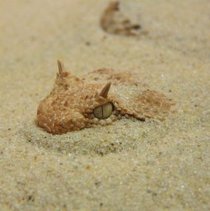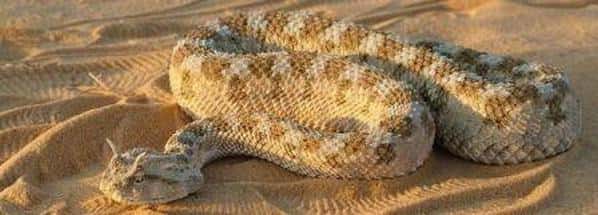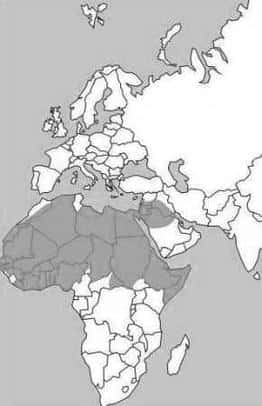Horned ViperCerastes cerastes |

Custom Search
|
In the Arabian Peninsula, the species occurs in southwestern Saudi Arabia, Yemen, Kuwait and parts of Qatar. Although there are reports of this species being found in Lebanon this is unlikely.
The average length for the horned viper is about 12 to 24 inches (30–60 cm) but can reach 33 inches (85 cm). These snakes have a robust body, narrow neck a thicker mid-body section and tapering tail that may have a black tip. A significant sexual dimorphism is present with females having smaller heads and eyes than males, but females are larger than males in size. The color pattern varies from brownish, yellowish, reddish to grayish and most often matches the soil color where the snake inhabits. In the back light brown and somewhat rectangular patches can be found, sometimes these blotches may fuse into crossbars and the underside is white. The species most distinctive characteristic is the presence of supraorbital "horns" over each eye from which derives their common name. However, in some individuals these "horns" may be smaller in size or even absent, creating "hornless" specimens. These modified scales are used to protect the snake's eyes from sand and also help it with camouflage.

The horned viper is a nocturnal creature, being active from dusk until dawn. They wriggle the body side to side to hide themselves in the sand.
For that reason they prefer dry areas with fine and loose sand and the occasional rock outcrop, preferably at higher elevations less prone to the harsh desert temperatures. They move by sliding the body sideways, in a type of movement is known as "sidewinding" like that of the sidewinder (Crotalus cerastes) found on the American continent. The species is also known by other common names including desert horned viper, desert sidewinding horned viper, Saharan horned viper, horned desert viper, Sahara horned viper, North African horned viper, African desert horned viper, greater cerastes, and asp. The name horned viper is sometimes used to refer other unrelated species like the horned puff adder (Bitis caudalis) of southwest Africa or the sand viper (Vipera ammodytes) found in southern Europe, the Balkans and the Middle East. The desert horned viper may have been the snake that inflicted Cleopatra’s fatal wound when she committed suicide, the other contender is the Egyptian cobra (Naja haje). Subspecies There are no subspecies are currently recognized but other 2 species are recognized in their genus, Cerastes, the Arabian horned viper (C. gasperettii) and the Sahara sand viper (C. vipera). Venom / Bite The horned viper venom is not very toxic and a bite while not usually fatal, can still have some serious consequences. The horned viper has hinged hollow fangs that unfold into the biting position when the snake opens its mouth, allowing the snake to deliver the venom very effectively. Their venom consists of 13 different toxins and it's composition varies by geographical location within the snake's range, with the most powerful blend causing hemorrhagic effects. A bite causes several symptoms like massive local swelling, acute pain, excessive bleeding or clotting, necrosis, nausea, abdominal pain, sweating, exhaustion, vomiting, hematuria, kidney failure and heart irregularities. The venom yield varies from 20 to 100 mg of dried venom, with an estimated lethal dose for humans around 40 to 50 mg. The LD50 values range from of 0.4 mg/kg (intravenous) and 3.0 mg/kg (subcutaneous). Diet / Feeding The horned viper feeds mainly on lizards but on occasion takes also on mammals and birds found in its desert and arid habitat. These snakes are ambush predators, they lie beneath the desert sand under vegetation or near rocks, with their distinctive horns and eyes barely visible. When their unsuspecting victim come close enough they strike with a stunning speed, holding on to the prey waiting until the venom takes effect. Reproduction These snakes locate their mating partners using the sense of smell to sense pheromones present in the air. The mating season occurs in the spring from April to June. This species is oviparous, and the female lays anywhere from 8 to 24 eggs usually beneath rocks or in abandoned burrows. The female may store the sperm on its body for several weeks before laying the eggs. The soft-shelled eggs hatch after an incubation period of 50 to 80 days, and the hatchlings measure about 5 to 6 inches (12–15 cm) in total length. The species becomes sexually mature at about 2 years of age and may live for 10 to 15 years or even more. Conservation / Threats The horned viper has not yet been assessed for the IUCN Red List. Although this species inhabits some the world’s more harshest environments, the horned viper population numbers are stable and the species isn't considered threatened. But like many other snakes, the habitat destruction, over-collection (for venom extraction), pollution and the introduction of invasive species have had a negative impact on them.
|
Scientific classification |
© 2014 Snake Facts About Us | Privacy Policy | Contact




